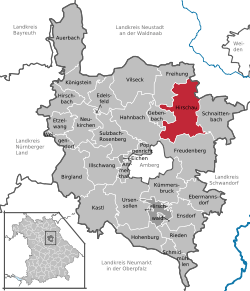Hirschau
From Wikipedia, the free encyclopedia
| Hirschau | ||
|---|---|---|
| ||
 Hirschau | ||
Location of Hirschau within Amberg-Sulzbach district  | ||
| Coordinates: 49°32′N 11°57′E / 49.533°N 11.950°ECoordinates: 49°32′N 11°57′E / 49.533°N 11.950°E | ||
| Country | Germany | |
| State | Bavaria | |
| Admin. region | Upper Palatinate | |
| District | Amberg-Sulzbach | |
| Government | ||
| • Mayor | Hans Drexler (CSU) | |
| Area | ||
| • Total | 74.90 km2 (28.92 sq mi) | |
| Population (2012-12-31)[1] | ||
| • Total | 5,819 | |
| • Density | 78/km2 (200/sq mi) | |
| Time zone | CET/CEST (UTC+1/+2) | |
| Postal codes | 92242 | |
| Dialling codes | 09622 | |
Hirschau is a municipality in the Amberg-Sulzbach district, Upper Palatinate, Bavaria, Germany.
Geography
Hirschau lies directly on the Bundesstraße 14 (Nuremberg - Rozvadov), 13 km northeast of Amberg and about 65 km east of Nuremberg. Apart from the main village Hirschau, the municipality consists of the following villages:
- Burgstall
- Dienhof
- Ehenfeld
- Krickelsdorf
- Kricklhof
- Krondorf
- Massenricht
- Obersteinbach
- Steiningloh
- Untersteinbach
- Weiher
Economy
Kaolin, used for the production of porcelain, has been mined at Hirschau since 1901. Interesting is the Monte Kaolino, a 120 meter high mound made from 32,000,000 tons of quartz sand from excess sand in years of operation. It is now used as a (sand) skiing/camping resort during the summer months. It is also the place where the yearly Sandboarding Championships are held.
References
- ↑ "Fortschreibung des Bevölkerungsstandes". Bayerisches Landesamt für Statistik und Datenverarbeitung (in German). 31 December 2012.
This article is issued from Wikipedia. The text is available under the Creative Commons Attribution/Share Alike; additional terms may apply for the media files.
